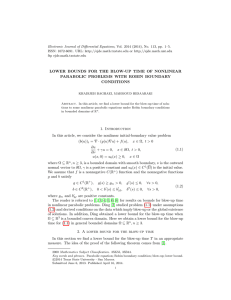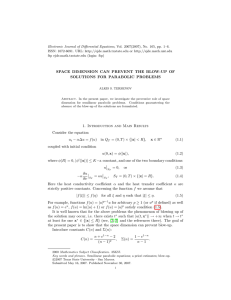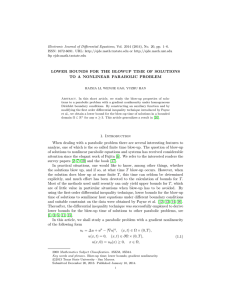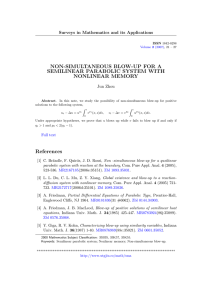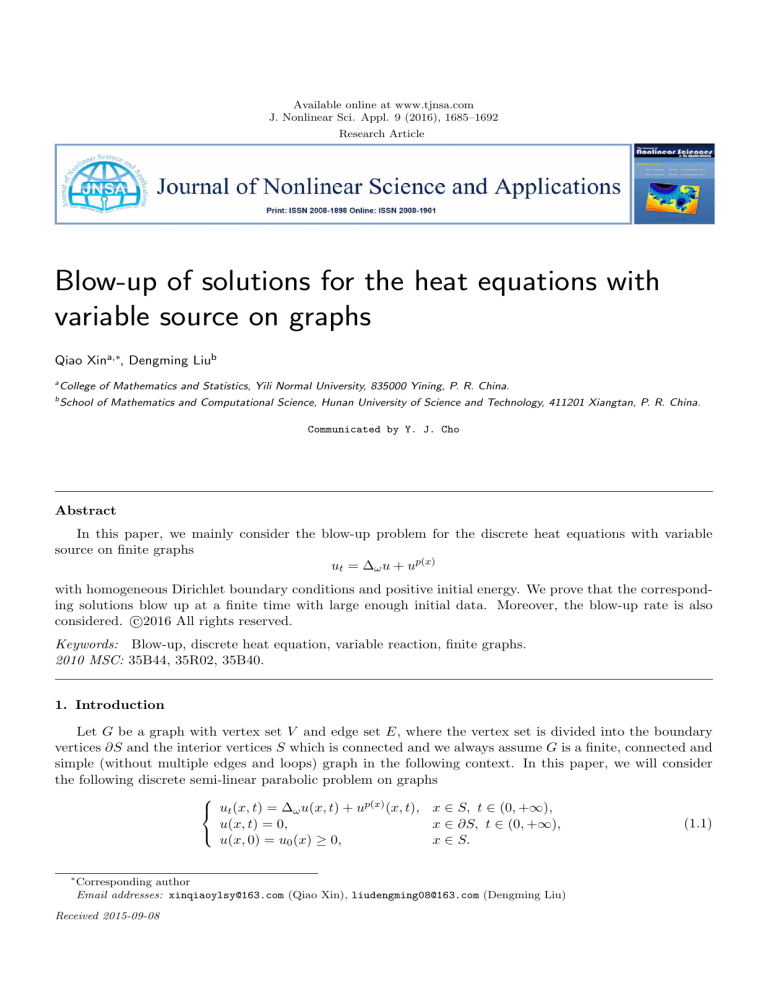
Available online at www.tjnsa.com
J. Nonlinear Sci. Appl. 9 (2016), 1685–1692
Research Article
Blow-up of solutions for the heat equations with
variable source on graphs
Qiao Xina,∗, Dengming Liub
a
College of Mathematics and Statistics, Yili Normal University, 835000 Yining, P. R. China.
b
School of Mathematics and Computational Science, Hunan University of Science and Technology, 411201 Xiangtan, P. R. China.
Communicated by Y. J. Cho
Abstract
In this paper, we mainly consider the blow-up problem for the discrete heat equations with variable
source on finite graphs
ut = ∆ω u + up(x)
with homogeneous Dirichlet boundary conditions and positive initial energy. We prove that the corresponding solutions blow up at a finite time with large enough initial data. Moreover, the blow-up rate is also
considered. c 2016 All rights reserved.
Keywords: Blow-up, discrete heat equation, variable reaction, finite graphs.
2010 MSC: 35B44, 35R02, 35B40.
1. Introduction
Let G be a graph with vertex set V and edge set E, where the vertex set is divided into the boundary
vertices ∂S and the interior vertices S which is connected and we always assume G is a finite, connected and
simple (without multiple edges and loops) graph in the following context. In this paper, we will consider
the following discrete semi-linear parabolic problem on graphs
ut (x, t) = ∆ω u(x, t) + up(x) (x, t), x ∈ S, t ∈ (0, +∞),
(1.1)
u(x, t) = 0,
x ∈ ∂S, t ∈ (0, +∞),
u(x, 0) = u0 (x) ≥ 0,
x ∈ S.
∗
Corresponding author
Email addresses: xinqiaoylsy@163.com (Qiao Xin), liudengming08@163.com (Dengming Liu)
Received 2015-09-08
Q. Xin, D. Liu, J. Nonlinear Sci. Appl. 9 (2016), 1685–1692
1686
where the function p(x) : S → (0, +∞) and p− := minx∈S p(x), p+ := maxx∈S p(x). C(V ) denotes the set of
all functions which are definite on the vertices V of the graph G and ∆ω denotes the ω−Laplacian operator,
which is defined as follows:
X
∆ω u(x) =
[u(y) − u(x)]ω(x, y),
(1.2)
y∈V
where the function ω(x, y) is called the weighted function and satisfies
(i) ω(x, x) = 0, for any x ∈ V,
(ii) ω(x, y) = ω(y, x) ≥ 0, for any x, y ∈ V,
(iii) ω(x, y) = 0, if and only if (x, y) ∈
/ E.
The parabolic equations involving sources like the ones in (1.1) occur in many applied mathematical
models, such as heat and energy transfer, electrical networks, image processing and so on [3, 5, 6, 9]. In the
continuous case, the following initial boundary value for the semi-linear heat equation
x ∈ Ω, t ∈ (0, +∞),
ut = ∆u + up(x) ,
(1.3)
u(x, t) = 0,
x ∈ ∂Ω, t ∈ (0, +∞),
u(x, 0) = u0 (x) ≥ 0, x ∈ Ω,
has been considered by many authors, the interested readers can refer to [7, 8, 10] and the references therein.
For the discrete case, when p(x) ≡ p > 1, the Problem (1.1) has been considered in [2, 11, 12]. However,
nonconstant powers seem to be new in the literature. In the next section, we will study the local existence of
positive solutions and then, the comparison principal to the Problem (1.1), when 0 < p(x) ≤ 1, the solutions
to the Problem (1.1) is global by the comparison. The existence of solutions which blows up in finite time
for sufficiently large initial data will be studied in the last section.
2. The local existence of solutions
Before prove the local existence of solutions, we need some basic knowledge on the heat kernel.
Suppose λ1 , λ2 , · · · , λn are the eigenvalues of the operator −∆ω on S with Dirichlet
P boundary condition,
the corresponding eigenfunctions are denoted by φj (x), j = 1, 2, · · · , n and satisfy x∈S |φ1 (x)|2 = 1, where
n = |S| is the number of vertices of the interior vertices S. Furthermore, set λ1 be the smallest eigenvalue of
−∆ω , it is well-known that λ1 > 0 and its corresponding eigenfunctions φ1 (x) can be chosen as φ1 (x) > 0.
Its proof can be found in the references [1, 4]. And then, the Laplacian operator −∆ω on S with Dirichlet
boundary condition can be written as
n
X
− ∆ω =
λ i Pi ,
(2.1)
i=1
where Pi is the projection of −∆ω to the i-th eigenfunction φi . For any t ≥ 0, the heat kernel Ht of the
subgraph S subject to Dirichlet boundary condition is defined to be the n × n matrix
Ht =
n
X
e−λi t Pi .
(2.2)
i=1
About the heat kernel, we have the following basic facts:
Lemma 2.1 ([1]). (i) The heat kernel Ht satisfies
Ht (x, y) =
n
X
i=1
e−λi t φi (x)φi (y).
(2.3)
Q. Xin, D. Liu, J. Nonlinear Sci. Appl. 9 (2016), 1685–1692
1687
P
(ii) For any function f (x) : S ∪ ∂S → R, set F (x, t) = y∈V Ht (x, y)f (y), we know that F (x, t) satisfies
the discrete heat equation with Dirichlet boundary condition and the initial value f (x), i.e.
Ft (x, t) = ∆ω F (x, t), x ∈ S, t ∈ (0, +∞),
F (x, t) = 0,
x ∈ ∂S, t ∈ (0, +∞),
(2.4)
F (x, 0) = f (x) ≥ 0,
x ∈ S.
Theorem 2.2. There exists T > 0 such that the Equation (1.1) has a unique solution in [0, T ].
Proof. Now, we begin with proving the local existence in time for the Equation (1.1). Assume u(x, t) is a
solution of the Equation (1.1), this leads to u(x, t) satisfies
Z tX
X
u(x, t) =
Ht (x, y)u0 (y) +
Ht−s (x, y)up(y) (y, s)ds.
(2.5)
0 y∈V
y∈V
Next, we define an inductively sequence un (x, t) as follows:
u1 (x, t) = 0,
Z tX
X
un+1 (x, t) =
Ht (x, y)u0 (y) +
Ht−s (x, y)unp(y) (y, s)ds.
(2.6)
0 y∈V
y∈V
We consider the convergence of the inductively sequence un (x, t). Set
Z tX
Ht−s (x, y)up(y) (y, s)ds,
Q(u) =
0 y∈V
we will prove the operator Q is contraction in
E = u(x, t)|u(xi , t) ∈ C 1 [0, T ], i = 1, 2, · · · , n and ku(x, t)k∞ ≤ M ,
where T > 0 is a fixed constant,
ku(x, t)k∞ := max max |u(x, t)|,
0≤t≤T x∈S
M is also a fixed positive constant and such that M > ku0 (x)k∞ . For any fixed x ∈ S, by the mean value
theorem, we get
up(x) − v p(x) = p(x)(θu + (1 − θ)v)p(x)−1 (u − v),
where θ(x) ∈ (0, 1) for any fixed x. Hence, for any u, v ∈ E, we have
kQ(u) − Q(v)k∞ =
Z tX
Ht−s (x, y) up(y) (y, s) − v p(y) (y, s) ds
0 y∈V
=
Z tX
∞
(2.7)
Ht−s (x, y)p(y)(θu + (1 − θ)v)p(y)−1 (u − v)ds
0 y∈V
≤ p+ (2M )p
∞
+ −1
µ(t)ku − vk∞ ,
RtP
where µ(t) = sup0≤t≤T | 0 y∈V Ht−s (x, y)ds|. On the other hand, we also have µ(t) → 0 when t → 0, so
+
we can choose T is small enough such that p+ (2M )p −1 µ(t) < 1 and then, we have Q is contraction. Thus,
due to (2.6), we have
kun+1 − un k∞ = kQ(un ) − Q(un−1 )k∞ ≤ p+ (2M )p
+ −1
µ(t)kun − un−1 k∞ .
Q. Xin, D. Liu, J. Nonlinear Sci. Appl. 9 (2016), 1685–1692
1688
So, we have the inductively sequence un (x, t) is convergent and its limit denotes by u(x, t).
Next, we consider the uniqueness. Suppose u
e(x, t) is another solution, it is easy to verify that
ku − u
ek∞ ≤ (p+ (2M )p
+ −1
µ(t))n−1 ku − u
ek∞
and then, let n → +∞ for both sides of the above inequality, we get
0 ≤ ku − u
ek∞ ≤ 0,
hence, u ≡ u
e. That is to say, the Equation (1.1) has a unique solution in [0, T ].
3. Global existence
To study the global existence of the solution to the Problem (1.1), we firstly need the comparison
principle. Now, we begin with the definition of the sup-solution and the sub-solution to the Problem (1.1).
Definition 3.1. A function ū(x, t) ∈ C(V ) × C 1 [0, T ) is called the sup-solution to the Problem (1.1), if it
satisfied
ūt (x, t) ≥ ∆ω ū(x, t) + ūp(x) (x, t), x ∈ S, t ∈ (0, T ),
(3.1)
ū(x, t) ≥ 0,
x ∈ ∂S, t ∈ (0, T ),
ū(x, 0) ≥ u0 (x),
x ∈ S.
Similarly, we can also define the sub-solution u(x, t) to the Problem (1.1) by reversing the Inequalities (3.1).
Now, we propose the comparison principle to the Problem (1.1), which will be used to study the global
existence of the solution to the Problem (1.1).
Theorem 3.2. Suppose ū(x, t) and u(x, t) be the sup-solution and the sub-solution to the Problem (1.1),
respectively. Then, for any (x, t) ∈ V × [0, T ), we have ū(x, t) ≥ u(x, t).
Proof. Set v(x, t) = u(x, t) − ū(x, t). Then, we have
vt (x, t) ≤ ∆ω v(x, t) + up(x) (x, t) − ūp(x) (x, t)
(3.2)
for any x ∈ S and t ∈ [0, T1 ], where 0 < T1 < T is an arbitrary constant.
Let v + (x, t) = max{v(x, t), 0} and then, multiplying v + both sides of the Inequality (3.2) and integrating
on V , we obtain
Z
Z
Z
1
+
2
+
(v (x, t))
≤
∆ω v(x, t)v (x, t) +
(up(x) − ūp(x) )v + (x, t).
(3.3)
2
x∈V
x∈V
x∈V
t
For the first term of the right part of the above inequality, we have
Z
∆ω v(x, t)v + (x, t) ≤ 0.
(3.4)
x∈V
In fact, let J(t) = {x ∈ V : v(x, t) > 0} and then, we have
P P
v+ (x, t)[v(y, t) − v(x, t)]ω(x, y)
x∈V P
y∈V P
P
P
=
v(x, t)[v(y, t) − v(x, t)]ω(x, y) +
v(x, t)[v(y, t) − v(x, t)]ω(x, y)
x∈J(t) y∈J(t)
x∈J(t) y∈V \J(t)
P P
P
P
[v(y, t) − v(x, t)]2 ω(x, y) +
v(x, t)[v(y, t) − v(x, t)]ω(x, y)
= − 12
x∈J(t) y∈J(t)
≤ 0.
x∈J(t) y∈V \J(t)
(3.5)
Q. Xin, D. Liu, J. Nonlinear Sci. Appl. 9 (2016), 1685–1692
1689
On the other hand, for any fixed x ∈ V , we have
up(x) (x, t) − ūp(x) (x, t) ≤ p(x)ξ p(x)−1 (x, t)v(x, t),
where ξ(x, t) = θ(x)up(x) (x, t) + (1 − θ(x))ūp(x) (x, t) is bounded in V × [0, T1 ] and 0 ≤ θ(x) ≤ 1. Now,
suppose
C = p+ × max ξ p(x)−1 (x, t).
x∈V,t∈[0,T1 ]
And then, for the second term of the right part of the Inequality (3.3), we also have
Z
Z
p(x)
p(x) +
(u
− ū )v (x, t) ≤ C
(v + (x, t))2 .
x∈V
(3.6)
x∈V
Combine the Inequalities (3.3), (3.4) and (3.6), we have
Z
Z
+
2
≤ 2C
(v (x, t))
x∈V
t
(v + (x, t))2 .
(3.7)
x∈V
Furthermore, since v + (x, 0) ≡ 0, hence, we can get v + (x, t) ≡ 0 for any x ∈ V and t ∈ [0, T1 ]. By the
arbitrariness of T1 , we obtain ū(x, t) ≥ u(x, t) for (x, t) ∈ V × [0, T ).
Now, we propose the global existence of the solution to the Problem (1.1) when p+ ≤ 1.
Theorem 3.3. Assume that p+ ≤ 1 and then, every solution to the Problem (1.1) is global.
Proof. We consider the following ODE:
z 0 (t) = z(t),
z(0) = max{maxx∈S u0 (x), 1}.
(3.8)
Observe that z 0 (t) = z(t) ≤ z p (t) for any p ≤ 1, hence, it is easy to verify that z(t) is sup-solution to
the problem (1.1) for p+ ≤ 1 and then, since z(t) is global, we have every solution to the problem (1.1) is
global.
4. Blow-up of solutions and Blow-up rate
About the Blow-up of the equation (1.1), we have the following theorem.
Theorem 4.1. Let u(x, t) be a positive solution of equation (1.1) and p− > 1, then, for a sufficiently large
initial datum, there exists a finite time T > 0 such that
ku(x, t)k∞ = +∞,
when t < T .
P
Proof. Firstly, define the
energy
function
η(t)
=
x∈V u(x, t)φ(x), where φ(x) > 0 is a eigenfunction to the
P
2
first eigenvalue λ1 and x∈S φ (x) = 1. And then, we get −∆ω φ(x) = λ1 φ(x). Furthermore, we have
X
X
X
η 0 (t) =
ut (x, t)φ(x) =
∆ω u + up(x) φ(x) = −λ1 η(t) +
up(x) φ(x).
x∈S
x∈S
x∈S
Let S1 = {x ∈ S : u(x, t) < 1} and S2 = {x ∈ S : u(x, t) ≥ 1}. By Jensen’s inequality, we have
P
P
P
p(x) φ(x) =
up(x) φ(x) + x∈S2 up(x) φ(x)
x∈S u
x∈S
1
P
−
≥ x∈S2 up φ(x)
P
P
P
−
−
−
= x∈S2 up φ(x) + x∈S1 up φ(x) − x∈S1 up φ(x)
P
P
−
≥ x∈S up φ(x) − x∈S1 φ(x)
P
−
≥ x∈S up φ(x) − n
p−
P
−
≥ n1−p
−n
x∈S (uφ)
−
p
= αη (t) − n,
Q. Xin, D. Liu, J. Nonlinear Sci. Appl. 9 (2016), 1685–1692
1690
−
where α = n1−p > 0 and then, we obtain
−
η 0 (t) ≥ −λ1 η(t) + αη p (t) − n.
−
Since α > 0 and the function f (η) = η p is convex, there exists δ > 1 such that
−
αη p ≥ 2(λ1 η + n), ∀η > δ.
It follows easily that if η(0) > δ, then η(t) is increasing on with respect to a certain interval and
η 0 (t) ≥
α p−
η (t).
2
Thus, we have
1−
α
−
η(t) ≥ η 1−p (0) − (p− − 1)t 1−p ,
2
hence, we have
lim η(t) = +∞,
t→t∗
where t∗ =
−
2
η(0)1−p .
α(p− −1)
Hence, the solution u(x, t) is not global for the case u0 (x) is large enough.
In the last context of this section, we consider the blow-up rate of the solution to the equation (1.1).
Theorem 4.2. Let u be the blow-up solution to the equation (1.1), T is the blow-up time and then, there
exist a positive constant C, such that
max u(x, t) ≤ C(T − t)
−
x∈S
where C = maxx∈S
Proof. Set d(x) =
P
1
p(x)−1
y∈V
1
p(x)−1
1
p+ −1
,
.
ω(x, y) and then, the Equation (1.1) can be rewritten as
ut =
X
(ω(x, y)u(y, t)) + up(x) − d(x)u,
(4.1)
y∈V
since u(x, t) > 0, so, we have
ut ≥ up(x) − d(x)u.
(4.2)
Since p(x) > 1 and the solution blows up, thus there exists a point x0 ∈ S and a time t0 , such that
up0 (x0 , t0 ) − d(x0 )u(x0 , t0 ) ≥ (1 − ε)up0 (x0 , t0 ),
(4.3)
where 0 < ε 1 and p0 = p(x0 ). From (4.3), the inequality holds for all times t0 ≤ t < T at this point, x0 ,
namely,
ut (x0 , t) ≥ (1 − ε)up0 (x0 , t).
(4.4)
Now, we consider the following ODE,
y 0 (s) = (1 − ε)y p0 (s), s > t
y(t) = A,
(4.5)
1
p −1
− 1
− 1
where A = (1 − ε) p0 −1 C0 (T − t) p0 −1 and C0 = p01−1 0 and then, we have the solution to the ODE
(4.5) blows up at the time T . Moreover, it is easy to verify that u(x0 , s) is a super-solution of this ODE, if
there exists t ∈ [t0 , T ) such that u(x0 , t) > A. Hence, we have u(x0 , s) > y(s) for all s ∈ [t, T ), so, by the
Q. Xin, D. Liu, J. Nonlinear Sci. Appl. 9 (2016), 1685–1692
1691
comparison, the solution u(x0 , t) blows up before the time T , which is a contradiction. Consequently, for all
times
− 1
− 1
u(x0 , t) ≤ A = (1 − ε) p0 −1 C0 (T − t) p0 −1 .
Since u(x, t) blows-up at the point x0 , thus, we have
−
max u(x, t) ≤ C(T − t)
1
p+ −1
x∈S
.
5. Example
In this section, we consider a graph G1 (as shown in Figure 1), which has six nodes x1 , x2 , · · · , x6 , where
x2 , x3 , x5 are interior and x1 , x4 , x6 are the boundary. Moreover, we only consider the weight function ω ≡ 1.
Thus, the problem (1.1) can be rewritten as
ut (x2 , t) = u(x3 , t) + u(x5 , t) − 3u(x2 , t) + up2 (x2 , t),
p3
ut (x3 , t) = u(x2 , t) + u(x5 , t) − 3u(x3 , t) + up (x3 , t),
ut (x5 , t) = u(x2 , t) + u(x3 , t) − 3u(x5 , t) + u 5 (x5 , t),
(5.1)
u(x2 , 0) = α > 0,
u(x3 , 0) = β > 0,
u(x5 , 0) = γ > 0.
Figure 1: The graph G1
We suppose that the exponents p2 = 1.4, p3 = 1.3, p5 = 1.2.
as follows:
3 −1
−1 3
− ∆ω =
−1 −1
Moreover, the operator −∆ω on the graph G1
−1
−1
(5.2)
3
√
√
√
and then, we have the first eigenvalue λ1 = 1, the corresponding eigenvector φ(x) = ( 33 , 33 , 33 )T . By
Theorem 4.1, we can choose (α, β, γ) = (3, 6, 9) and then, the solutions u(x2 , t), u(x3 , t), u(x5 , t) will blow
up. Since the Systems (5.1) is nonlinear, it is difficult to compute its analytic solutions. Thus, we consider
its numerical solutions. The explicit difference scheme to the Systems (5.1) is as follows:
un+1 (x )−un (x )
2
2
= un (x3 ) + un (x5 ) − 3un (x2 ) + (un (x2 ))1.4 ,
n+1 ∆t n
u
(x3 )−u (x3 )
= un (x2 ) + un (x5 ) − 3un (x3 ) + (un (x3 ))1.3 ,
un+1 (x5∆t
n
)−u (x5 )
= un (x2 ) + un (x3 ) − 3un (x5 ) + (un (x5 ))1.2 ,
(5.3)
∆t
u(x2 , 0) = 3,
u(x3 , 0) = 6,
u(x5 , 0) = 9,
Q. Xin, D. Liu, J. Nonlinear Sci. Appl. 9 (2016), 1685–1692
1692
Figure 2: Blowup of the equation (1.1)
where un (xi ) denotes u(xi , n∆t) for i = 2, 3, 5 and ∆t is the time step which equals 0.01 in the numerical
experiment. The numerical experiment result is shown in Figure 2. From this numerical experiment, we
know the solution will blow up in finite time, moreover, the blowup time strongly depends on the exponent
p− .
6. Conclusion
Our main theorem only considers the blow-up of the solution in the case p(x) > 1, however, for the case
≤ 1 ≤ p+ , there also exists blow-up, the further work will be needed to settle. Moreover, the critical
exponent seems to depend in another way, we will consider in the further work.
p−
Acknowledgements
The first author is supported by the Natural Science Foundation of Uygur Autonomous Region of Xinjiang(Grant No.201442137-30) and the National Natural Science Foundation of China (Grant No.11461075).
The second author is supported by Scientific Research Fund of Hunan Provincial Education Department
(Grant No.14B067). The authors thank the referees for their detailed comments.
References
[1] F. R. K. Chung, Spectral graph theory, CBMS Regional Conference Series in Mathematics, American Mathematical Society, Providence, (1997). 2, 2.1
[2] S. Y. Chung, Critical blow-up and global existence for discrete nonlinear p-laplacian parabolic equations, Discrete
Dyn. Nat. Soc., 2014 (2014), 10 pages. 1
[3] S. Y. Chung, C. A. Berenstein, ω-harmonic functions and inverse conductivity problems on networks, SIAM J.
Appl. Math., 65 (2005), 1200–1226. 1
[4] Y. S. Chung, Y. S. Lee, S. Y. Chung, Extinction and positivity of the solutions of the heat eqautions with absorption
on networks, J. Math. Anal. Appl., 380 (2011), 642–652. 2
[5] E. B. Curtis, J. A. Morrow, Determining the resistors in a network, SIAM J. Appl. Math., 50 (1990), 918–930. 1
[6] A. Elmoataz, O. Lézoray, S. Bougleux, Nonlocal discrete regularization on weighted graphs: A framework for
iamge and manifold processing, IEEE Trans. Image Prcoess., 17 (2008), 1047–1060. 1
[7] R. Ferreira, A. de Pablo, M. Préz-LLanos, J. D. Rossi, Critical exponents for a semi-linear parabolic equation
with variable reaction, Proc. R. Soc. Edinburgh, 142 (2012), 1027–1042. 1
[8] J. P. Pinasco, Blow-up for parabolic and hyperbolic problems with variable exponents, Nonlinear Anal., 71 (2009),
1094–1099. 1
[9] V. Ta, O. Lézoray, A. Elmoataz, S. Schüpp, Graph-based tools for microscopic cellular image segmentation,
Pattern Recognit., 42 (2009), 1113–1125. 1
[10] X. Wu, B. Guo, W. Gao, Blow-up of solutions for a semilinear parabolic equation involving variable source and
positive initial energy, Appl. Math. Lett., 26 (2013), 539–543. 1
[11] Q. Xin, L. Xu, C. Mu, Blow-up for the ω-heat equation with dirichlet boundary conditions and a reaction term
on graphs, Appl. Anal., 93 (2014), 1691–1701. 1
[12] W. Zhou, M. Chen, W. Liu, Critical exponent and blow-up rate for the ω-diffusion equations on graphs with
dirichlet boundary conditions, Electron. J. Differential Equations, 2014 (2014), 13 pages. 1


